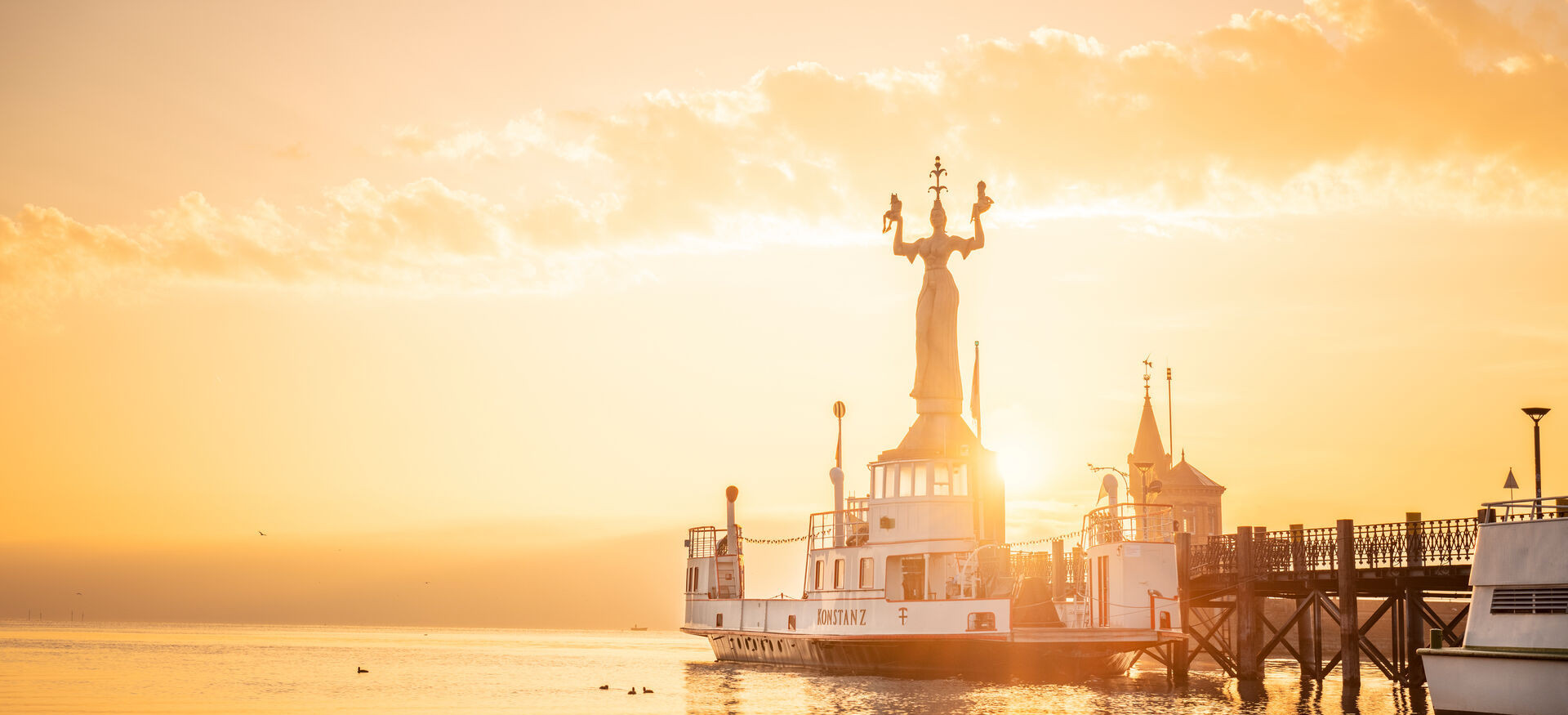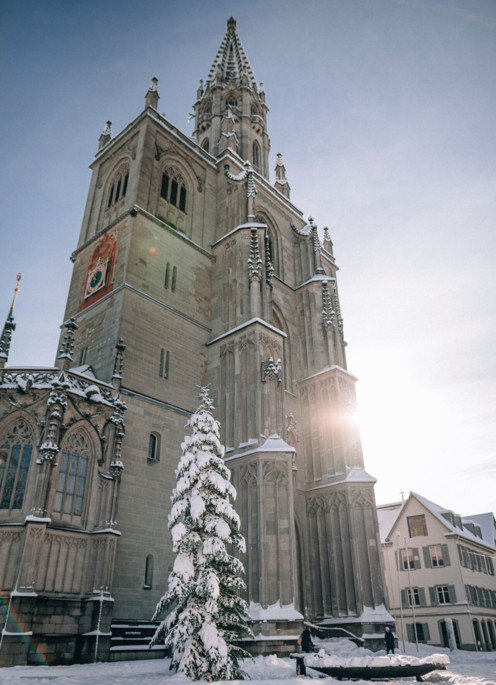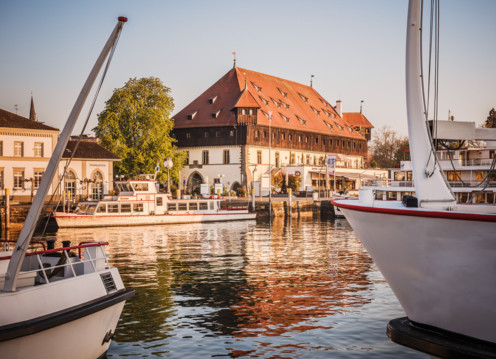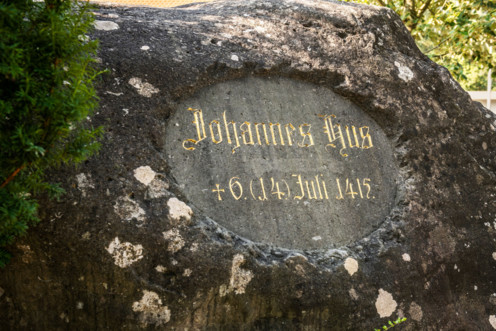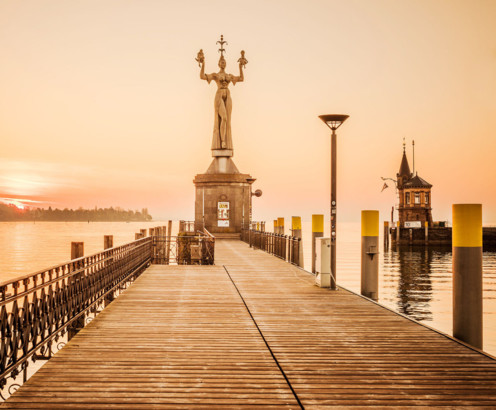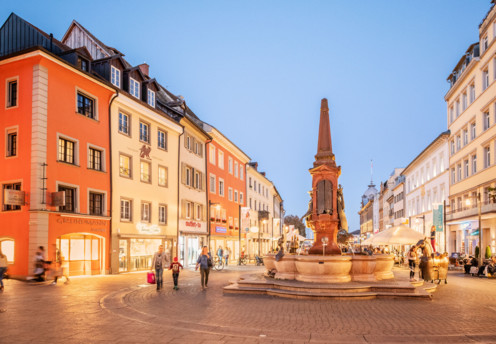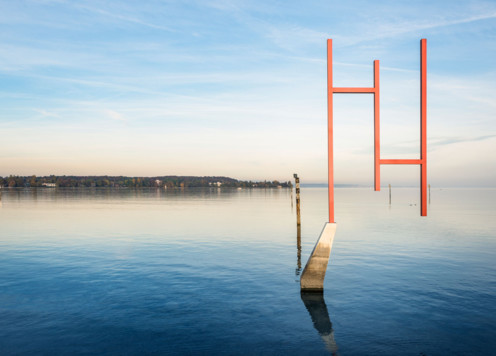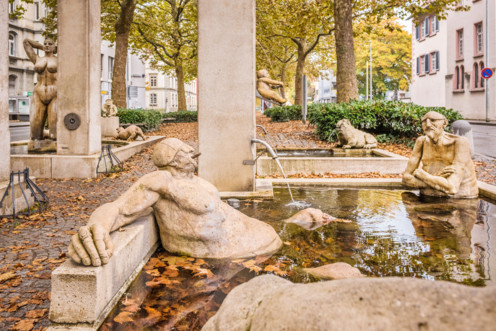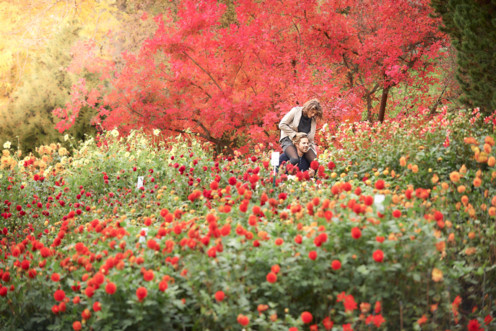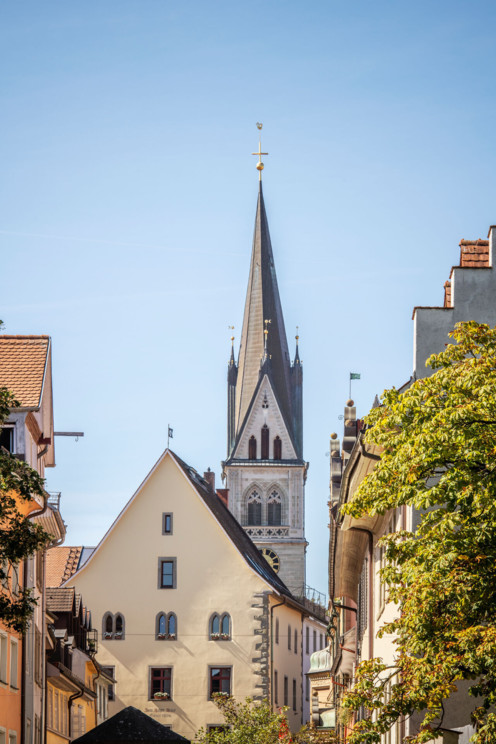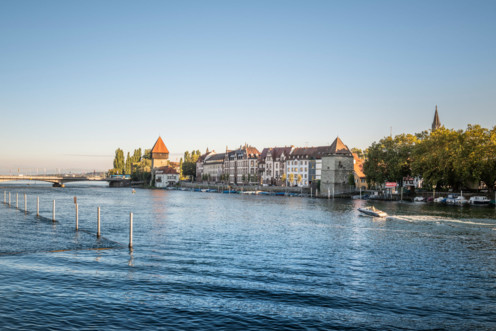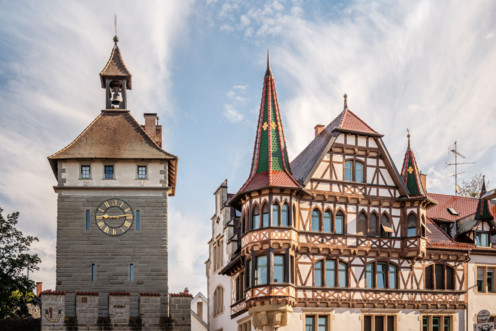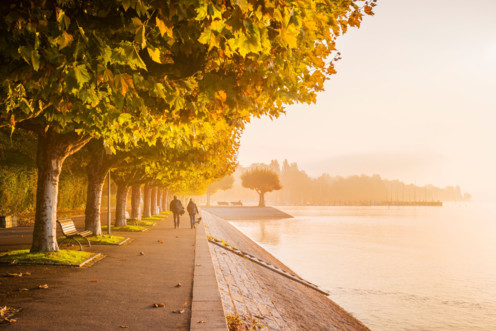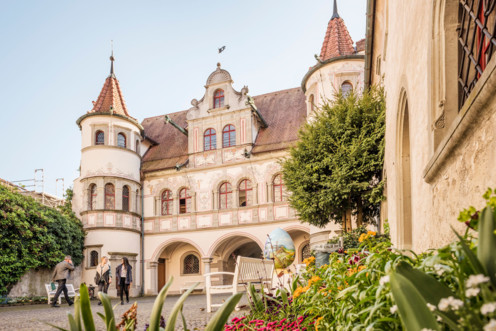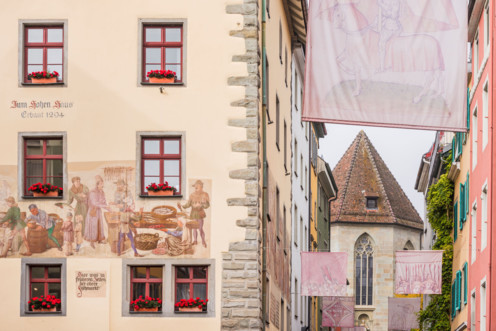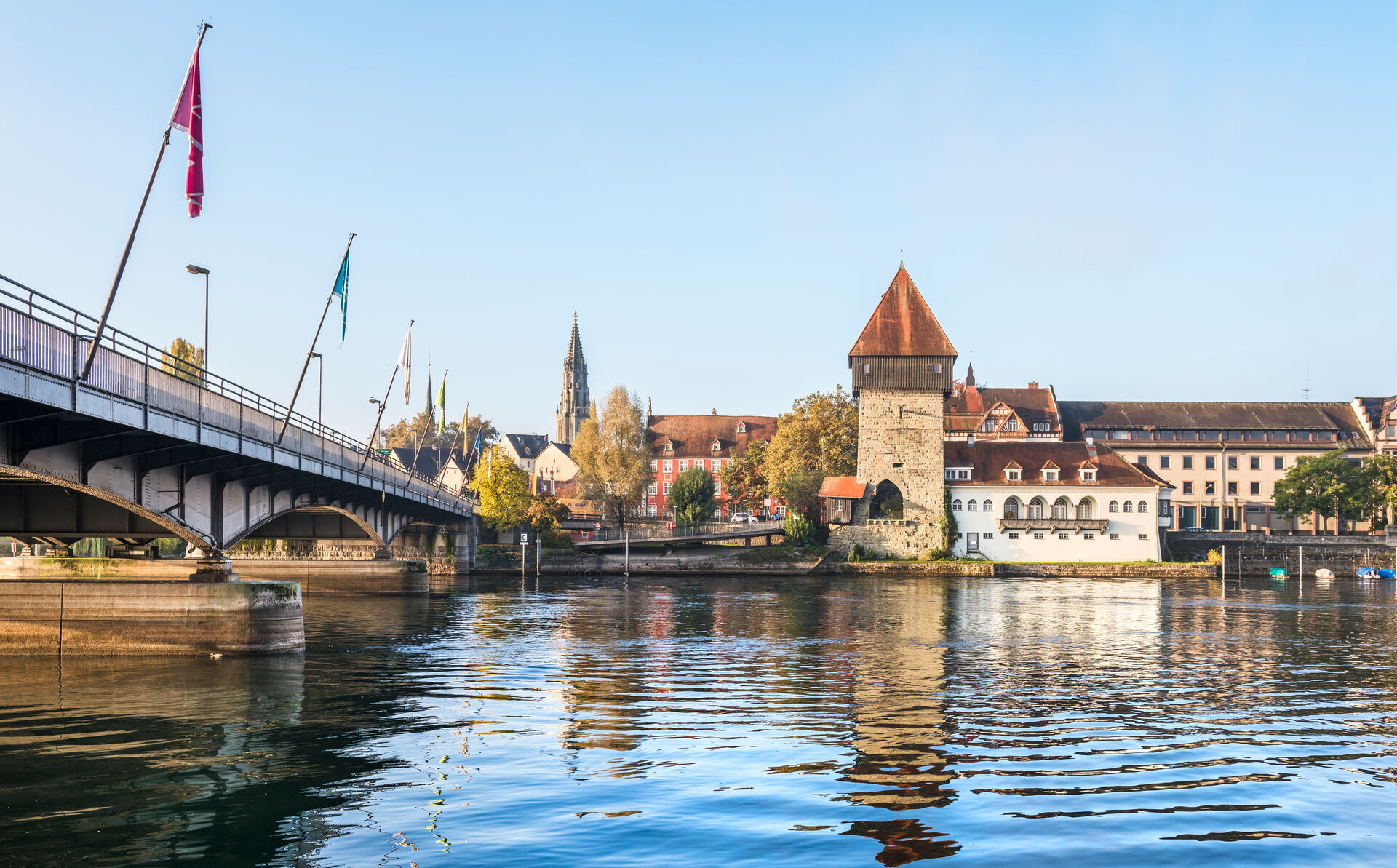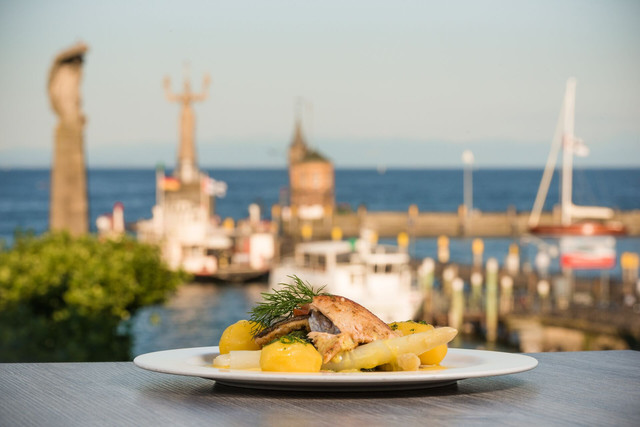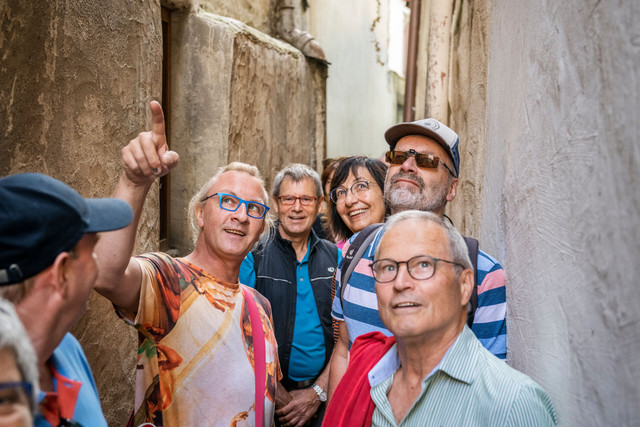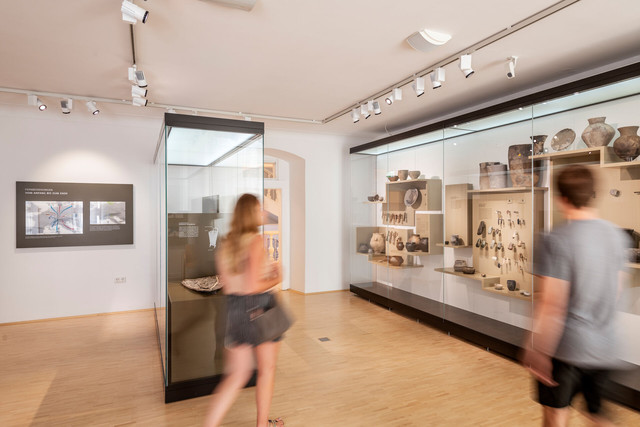The Council of Constance as a witness to historic world events, the Niederburg as the oldest part of the city, the Imperia as a landmark visible from afar, historic city towers and numerous other sights invite you to inspiring strolls in the most beautiful city on Lake Constance.
-
![]()
From the ruins of the late Roman fort that stood on the same site, a first cathedral church emerged by no later than the 7th century. The Romanesque columned basilica, inaugurated in 1089 as part of the Diocese of Constance until its dissolution in 1821, underwent numerous alterations and renovations after the Reformation. The last of these was the addition of the neo-Gothic spire in 1853. The cathedral was granted the title of ‘minor basilica’ in 1955.
Decisions of historic importance were made here, for example during the Council of Constance 600 years ago. This was where the synod convened that condemned the Prague church reformer Jan Hus to death for heresy on 6 July 1415.
TIP: Popular event locations: Constance cathedral and the cathedral square
The building and its square provide the historical backdrop to a wide range of events, including concerts, festivals and the open-air-theatre...
Sights worth seeing inside the cathedral
- Crypt: Dating from the 9th/10th century with the four original gilded medallions from the outer wall of the chancel. The largest in this store of treasure, unique in the Christian world, is the "Majestas Domini" that dates from around the year 1000.
- St Maurice's Rotunda: A circular structure built in around 940 as a replica of the Church of the Holy Sepulchre in Jerusalem. In its centre lies the Holy Sepulchre, restored in the 13th century. The Rotunda was the starting and finishing point for great medieval pilgrimages, for example on the Swabian Route to Santiago de Compostela. The decorative figures and frescoes date from the Gothic and Renaissance periods.
- Cloister: Some parts date back to the 13th to 15th century. Late-Gothic frescoes can be seen in the St Sylvester's Chapel.
- St Conrad's Chapel: Dating from the 13th century, with the Crucifixion altar of Bishop Hugo von Hohenlandenberg (16th century).
- St Thomas Chancel: The late-medieval staircase known as the 'Schnegg' is richly decorated with figures and particulary striking.
- East chancel: Gothic pews with ornate woodcarvings and a Romanesque Madonna from the 13th century.
- Central nave: Romanesque monolithic columns from the 11th century, pulpit from 1680.
- Welser Chapel: A masterpiece of a late-Gothic sculpture.
- Westwerk: An early 16th century Renaissance organ and frescoes dating from various periods are located here...
- Entrance hall: Late-Gothic double doors and the "Great Christ of Constance".
TIP: Guided tours of the cathedral.
There are many more fascinating features inside the cathedral, some of which can only be seen on one of the regular guided tours in the summer months. Accompanied tours are also possible at other times, by prior arrangement. -
![]()
600 years of history: the Council of Constance building was erected between 1388 and 1391 as a grain store and warehouse and hosted the Constance canvas fair for a time. From 1414 to 1418, it was the venue for the only election of a pope north of the Alps. The conclave convened from 8 to 11 November 1417 on the first floor of the building and elected Cardinal Otto Colonna, under the name Martin V, as the sole Pope.
In the 19th century, the upper hall was used for an exhibition of commemorative artefacts on the Council of Constance, and as a result, the building became known as the ‘Konzil’ (Council). Altered several times since that time, this historical building has been used as a venue for concerts and events since the beginning of the 20th century.
-
![]()
The 350-hundredweight Hus Stone lies at the place where Bohemian reformers Jan Hus and Jerome of Prague were burned at the stake for heresy during the Council of Constance. Now, a commemoration ceremony for the two men is held here every year on 6 July, the day of Hus’ death.
-
![]()
Standing nine metres tall and weighing at 18 tonnes, the Imperia statue by local artist Peter Lenk has been a focus of discussion ever since it was erected, in particular the naked figures she holds in her hands. Imperia holds aloft King Sigismund in her right hand and Martin V, the Pope elected by the Council of Constance, in her left. Lenk portrays them as grotesque figures who have unlawfully taken possession of the insignias of power.
The brainchild of the former Constance Tourist Information Office (now the MTK) and the artist himself, the statue was created without the use of public money and financed by sponsors. At the time, the erection of the statue caused a heated public debate, and even the world's media reported on it. Since then, the Imperia statue has become one of the most popular destinations for tourists in Constance. It establishes a literary connection to French romantic novelist Honoré de Balzac's stories of the "beautiful Imeria" at the time of the Council of Constance" (1414 - 1418), even if, according to literary historian Professor Helmut Weidhase, Imperia is said to have lived between 1455 and 1511.
TIP: Guided tour "The Presence of the past "
There still are many places of interest that bear witness of the Council of Constance of 600 years ago, the only time a pope was elected north of the Alps. The guided tour "The presence of the past" delves into history of Constance on visits on the Imperia statue, the Council of Constance building, the Hus stone and other, less well-known settings of this momentous event.
-
![]()
The Kaiserbrunnen fountain was built in 1897, and the figures decorating it were replaced in 1990s. Since then, the fountain in the centre of the old quarter on Marktstätte square has featured caricatures such as a three-headed peacock with three papal tiaras. These commemorate the Council of Constance held from 1414 to 1418.
-
![]()
The Kunstgrenze has been a particularly attractive part of the border between Germany and Switzerland for more than ten years thanks to its 22 individual metal sculptures depicting tarot cards. With motifs including the Magician, the Empress, the Wheel of Fortune, and the Fool, the sculptures symbolise the conditions of human existence and offer the observer a wide range of perspectives and interpretations.
On 28 April 2017, the Kunstgrenze celebrated its tenth anniversary with a transnational get-together featuring food, drink, jazz and speeches by Andreas Netzle, the mayor of Kreuzlingen, and Uli Burchardt, the mayor of Constance.
-
![]()
Striking and particular, the Lenk fountain entertains passers-by and drivers on one of Constance's main thoroughfares. The fountain features caricatures of more than 300 notable personalities by local artist Peter Lenk.
TIP: The Lenk fountain is only a short walk from St.-Stephans-Platz, the venue for one of the two popular weekly markets and the annual Constance wine festival at the end of July...
-
![]()
Magnificent flowers, romantic walks, breathtaking nature and a flower island: the Mainau offers in every season fascinating experiences for all the family. Open 365 days a year, from sunrise to sunset, the Mainau experience can be enjoyed year-round. Highlights such as the orchid show, the Count’s Island Festival , the wedding fair, the winter exhibition and much more complete the diverse range of the colorful flower Island.
-
![]()
The picturesque alleys and facades, cosy taverns and restaurants in Constance's oldest quarter provide the perfect backdrop for a relaxed stroll or a fun shopping spree.
The Niederburg quarter begins to the north of the cathedral, and its name – German for lower castle – derives from the area’s location beneath the former Bishop’s Castle on the Rhine. With its many frescoes and handsome patrician town houses, the quarter exudes a particular charm that takes visitors back to a time long forgotten.
Although many of the buildings were destroyed in a fire in 1355, there are still plenty of late-medieval houses to see in Niederburg. The quarter was once home to artisans, fishermen and minor merchants, including bondsmen of the bishop.
There are also a number of grander homes that were once the residences of wealthy members of the clergy, and in Kloster Zoffingen the quarter is home to the only remaining convent in the former episcopal town. The Spitalkellerei winery can also be found in Niederburg.
-
![]()
Prison and gateway to the town – Rheintor tower was built in around 1200 as a prison and northern gateway to the town. In the early 14th century, Pulverturm tower was added to reinforce the town’s defences. For a time, it also served as the local prison, for example to hold a number of Jews imprisoned after the Council of Constance.
-
![]()
Along with the Pulverturm and Rheintor towers, this 14th century edifice is the only defensive structure from medieval Constance that is still in existence. The half-timbered exterior of this southernmost extension of the town's defences is a real eye-catcher.
Tip: Whether on a stroll, on a guided tour or on a shopping spree, visitors to the old quarter will find Schnetztor tower a constant companion...The ‘Walk through the wall’ tour to Neugasse is an unmissable highlight of any trip to Constance. -
![]()
Seestrasse follows the shore of the lake and offers an attractive mix of urban flair and glorious views. With the blue sky above, the many green trees all around and the waters of the lake shimmering gently, there are few better places to unwind. You could have a cosy outdoor picnic, for example, or head off on a leisurely stroll along this popular and picturesque street. Dip your toes in the cool waters, breathe in the fresh air and soak up the atmosphere of Lake Constance …
-
![]()
There are many treasures to be found among the buildings of the town council offices, from the Italian Renaissance-style courtyard and the former linen weavers' guildhall to murals and the Haus Zum Thurgau. And there is as much to admire inside as there is outside, for example the artworks on show in the town hall Gallery.
The courtyard is well worth seeing and captures the spirit of the Italian Renaissance. At the heart of this architectural ensemble lies the former linen weavers’ guildhall (Zur Salzscheibe), which was rebuilt during the 16th century with entrances on Kanzleistrasse and Blätzle Platz square. The council chamber, with its entrance on Hussenstrasse, however, is located within the walls of the late-medieval Haus Zum Thurgau.
The paintings of 1864 on the facade that faces Kanzleistrasse depict important scenes from the town’s history, such as the Burgrave of Nuremberg assuming control of the March of Brandenburg in 1417. Equally illuminating are the frescoes in the first floor entrance hall, painted by Carl von Häberlin in 1898. The town hall gallery is also a venue for special exhibitions.
TIP: Receptions and other events in the courtyard
After tying the knot in the historical town hall building, married couples can celebrate their wedding with a reception in the romantic setting of the courtyard. And during the summer months, the open-air chamber opera held here in the courtyard provides a platform for high-calibre musicians and new talent alike.
-
![]()
The "Hohe Haus" (Tall House) features prime examples of the colourful frescoes that were painted on the facades of buildings in the old quarter during the Middle Ages. Constance has more frescoes than any other town or city in the German-speaking countries. Further impressive frescoes can be found on Trinity Church and on Haus Zum goldenen Löwen and Haus Zur Kunkel.

